In the brilliant and surreal Centuria number twenty-two[1] written by Giorgio Manganelli, abstract reasoning is carried out about a unique capability that the desert produces every day, a highly intricate action, which is thinking. While this activity might appear absurd to many the desert, in its calm and tranquil serenity, is a tireless engine that works to conceive projects according to a precise mental blueprint. If one gets caught in the whirlwind of analogies induced by this bizarre vision, it’s not absurd to imagine the panorama Rome as a somewhat thoughtful desert, precisely due to its immortality and perpetual transformation driven by sublime aspiration.
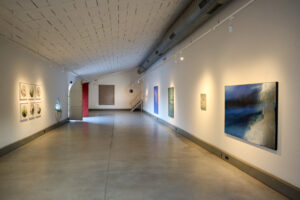
A.A.V.V., Nella pittura. Roma capitolo I, installation view, ph. Credit Willem Zaeyen, courtesy Galleria Il Frantoio, Capalbio
The exhibition Nella pittura capitol I is founded upon this extraordinary relationship. The group show is curated by Massimo Mininni and Davide Sarchioni, scheduled from June 30th to September 3rd 2023 at Galleria Il Frantoio in Capalbio by Maria Concetta Monaci, featuring works by Paolo Assenza, Romina Bassu, Verdiana Bove, Marco Eusepi, Krizia Galfo, Luca Grechi, Luca Grimaldi, Diego Miguel Mirabella and Katia Pugach. And if, in all honesty, Rome’s grandeur resides in being a desert – a place of boundless and fluid ideation due to its softly changing surface – the curators have reinterpreted the capital’s panorama with a decidedly non-obvious intention: to recount this reality anew, even while redoing everything in a different manner. Furthermore, the principle of unity among the artists can be summarized in an urgent question addressed to each of them, generated by an impartial observation as much as Manganelli’s admirable insight: What does the desert project and what idea does it have of itself?[2]
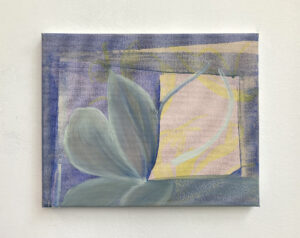
Luca Grechi, Spicchio d’alba, 2023, mixed media on canvas, 24 x 30 cm, courtesy LABS Contemporary Art, Bologna
A lucid and comprehensive response can be found within the works for anyone seeking to understand the essence of painting itself; this pertains to the works of Luca Grechi and Marco Eusepi, which reveal what is internally intertwined with their connection to creation. In the veins of Luca Grechi flows a dear love directed towards nature, of remarkable splendor. His small-format works reveal a newfound independence in the carnal stroke, moved by new currents of air and reflections, overlapping without blending, thereby displaying an elegant and exquisite chromatic cheerfulness. Thus, once again, Grechi demonstrates a desire for contact with human slowness and its actuality, bringing to the canvas what he knows, rather than merely what he sees. Hence, the artist’s choice to give body and concreteness to a petal, preferring to emphasize the sense of smell along with its incessant blossoming that continuously varies in color, like the ever-changing reflections of the sky in its soft tones. If for the artist, contemplation is equivalent to seeking new visions beyond bare reality, observation is aimed at discovering a work ethic. Thus, his painting flows as slowly as his internal visions, hidden by a learned and reflective approach.

Marco Eusepi, Untitled (Flowers), acrylic on canvas paper, 24 x 32 cm, 2019, ph. Credit Roberto Apa, courtesy l’Artista e Galleria Secci
An inventive freedom centered around natural chromatic hues is also embodied by Marco Eusepi. His works, also in small format, captivate by being brimming with sunlight and sparkling happiness. The imprinted forms seem to swell before exploding into boundless liberation. Eusepi, bound by a subtle naturalistic classicism, gathers the energy of sugary nectar from every pistil, employing a painting technique rooted in bright chromatic gestures and his unbridled touch. And as Eusepi manages to extract ecstatic beauty from a cluster of flowers, with only the sunlit patches of color highlighted, the resulting works are constructed with the typical green of living grass, a fiery lilac of life and a high mountain sky blue.
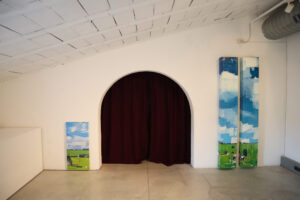
A.A.V.V., Nella pittura. Roma capitolo I, installation view, ph. Credit Willem Zaeyen, courtesy Galleria Il Frantoio, Capalbio
While with these artists, one gets the sensation of having brushed against the ethereal, with Paolo Assenza, on the other hand, one touches the ground and the flashes in the shimmer of a sunset with green undertones. The swirling glimpses seem to herald an impending storm, and even though nothing discernible takes shape except dreamlike and fantastical halos, there lies the expanse of a peninsula nestled between seas, within the context of the mirage of evening light. And if we allow ourselves to be guided by the seemingly insular geography that the artist portrays, what remains is the clear and vibrant perception of the narrative of his painting: a hypnotic landscape constructed through subtle and expansive veils. Similarly, with Katia Pugach, movement is crystallized and reassembled through unrelenting geometric tension, also demanding dynamic spectatorship. The artist embroiders optical seismograms, whereby the strictly ordered forms evoke wondrous perspectival speculations. Each strict brushstroke is encapsulated in a play of geometric patterns, showcasing a novel way to reflect a reassuring geometry encrypted with proportions devoid of chaos. Differently with Verdiana Bove, painting becomes a nostalgic and melancholic obsession, where color and essence are intertwined in an incessant visual transmutation. In this way, starting from a conception of life that emerges through memories, Bove shapes her cold universe of dissonances. However, she moves according to specific spatial and temporal coordinates, where space is a collection of points and time is an absurd simultaneity of moments. Thus, by reducing the distance between content and form, events seem to happen in the representation, suddenly emerging all at once.

Romina Bassu, The Comparison, 2023, acrilico su tela, 80 x 60 cm, courtesy l’Artista e Studio SALES di Norberto Ruggeri, Roma
Spatial dislocation is the essence of Krizia Galfo‘s works, displayed in a space that’s challenging to observe. However, they stand out due to an obvious and brilliant choice of a painting style developed for fragmented and multiple points of view. What has been achieved, even without a sentimental meaning, embraces realistic shades of reality, like visual enchantments. The artist, immersing themselves in the painterly threshold, allows the character to reveal itself in a hidden confession with a tangible real adherence. Likewise, with Romina Bassu, a rare capacity for unveiling is to be recognized, an ingenious and steadfast juxtaposition, characteristic of “extreme” painters who always have something authentic to communicate. Bassu suggests that one must be persistent when creating, resulting in the staging of the most refined visual games and intertwinements. While the painting appears methodical in certain aspects, in other parts – particularly in the faded, ephemeral approach – there is the revelation of an image that strips the aura from what is seemingly customary, inviting us to reinterpret the image with a new sense.
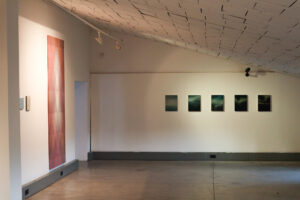
A.A.V.V., Nella pittura. Roma capitolo I, installation view, ph. Credit Willem Zaeyen, courtesy Galleria Il Frantoio, Capalbio
Similarly, Luca Grimaldi opens the gateway to novel visuals based on a playful and perspective-farcical aspect, emphasizing the visual value using white, interspersed with constructive brushstrokes aimed at suggesting a fictitious set design. With this artist, there’s always something electrifying about the chosen subjects, as he approaches them with the intent to completely change them, functioning as a “prodigious cannibal” that deconstructs iconographies while simultaneously orchestrating a polyphony of familiar fragments with places, people, and animals. Lastly, with Diego Miguel Mirabella, painting enters the realm of sacred art, akin to writing that he wields with utmost freedom, thereby challenging the most conventional common thoughts. Radiant with light and intelligence, the exhibited work conceived in the year 2022 shines brightly. As an opening towards successful and new exploration, the other works at the pinnacle feature stylistic elements bearing the artist’s name, now enhanced by provocative contours. Mirabella, in other words, is nothing less than a chimeric sculptor of a reflective and lapidary language, rich with inflections in the interplay between perception and word. Thus, with this exhibition project, the Roman desert, which was somewhat contemplative and seemingly still as introduced at the beginning, now explicitly reveals itself as a place of shared reflection. By evading unnecessary and reductive labels of affiliation, which have been overly instrumentalized for some over the past two years, a natural dialogue is prioritized for a new guise of painting – a compendium of a prolific desert fantasy composed of water, flowers, and golden, warm sand.
Maria Vittoria Pinotti
[1] Giorgio Manganelli, Centuria, Cento piccoli romanzi fiume, Adelphi Edizioni, (1995), 2023, p. 261
[2] Ibidem
Info:
A.A.V.V. Nella pittura. Roma capitolo I
curated by Massimo Mininni e Davide Sarchioni
30/6/2023 – 3/9/2023
Galleria Il Frantoio, Piazza della Provvidenza, 10, 58011, Capalbio
www.associazioneilfrantoio.it
Opening hours: From Wednesday to Monday, 6:00pm to 11:00pm, closed on Tuesdays
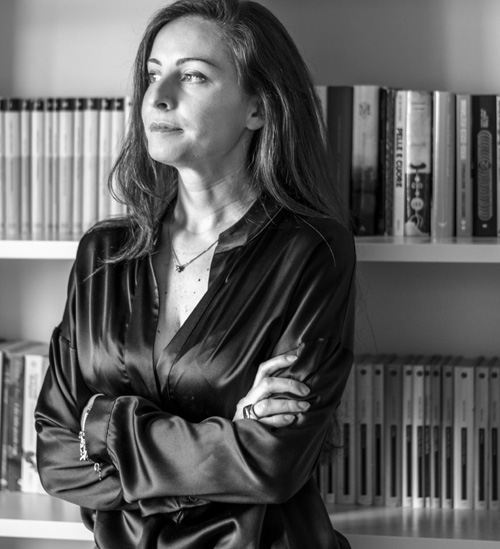
Maria Vittoria Pinotti (1986, San Benedetto del Tronto) is an art historian, author, and independent critic. She currently is the coordinator of Claudio Abate’s photographic archive and Manager at Elena Bellantoni’s Studio. From 2016 to 2023 she was the Gallery Manager in a gallery in the historic center of Rome. She has worked with ministerial offices such as the General Secretariat of the Ministry of Culture and the Central State Archive. Currently, she collaborates with cultural sector magazines, focusing on in-depth thematic studies dedicated to modern and contemporary art.






NO COMMENT